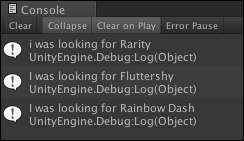We're going to create an array, a list and a dictionary, then loop through each one to retrieve the desired data from each one by using foreach loops.
- Modify
LearningScriptas shown in the next screenshot. - Save the file.
- In Unity, click on Play.

As we looped through each list, we decided which data to display to the Console:

The analysis of the code is as follows:
For each list we created, we populated them using a Collection Initializer.
- The code between lines 9 and 10 with its description:
string[] ponyArray = new string[] {"AppleJack", "Rarity"};A
stringarray namedponyArrayis declared and two strings are added. - The code on line 12 with its description is as follows:
foreach(string pony in ponyArray)
A
foreachloop is used to retrieve one element, a pony name string, stored inponyArray.A variable is declared named
ponyto hold the retrieved pony name.Once a pony name is retrieved, the
foreachcode block, lines 13 to 16, is executed.This looping continues until each element in
ponyArrayhas been retrieved and tested in the code block. - The code on line 14 with its description is as follows:
if(pony == "Rarity");
If the retrieved string stored in
ponyis equal to"Rarity", then line 15 executes. - The code on line 15 with its description is as follows:
Debug.Log("I was looking for " + pony);The string I was looking for plus the string value stored in pony is displayed in the Console.
- The code between lines 18 and 19 with its description:
List<string> ponyList = new List<string>() {"Princess Cadence", "Fluttershy"};A
ListnamedponyListis declared that will store thestringtype, and two strings are added. - The code on line 21 with its description is as follows:
foreach(string pony in ponyList)
A
foreachloop is used to retrieve one element, a pony namestring, stored inponyList.A variable is declared named
ponyto hold the retrieved pony name.Once a pony name is retrieved, the
foreachcode block (that is, lines 22 to 25) is executed.This looping continues until each element in
ponyListhas been retrieved and tested in the code block. - The code on line 23 with its description is as follows:
if(pony == "Fluttershy")
If the retrieved string stored in
ponyis equal to"Fluttershy", then line 24 executes. - The code on line 24 with its description is as follows:
Debug.Log("I was looking for " + pony);The string I was looking for plus the string value stored in
ponyis displayed in the Console. - The code between lines 27 and 28 with its description:
Dictionary<int, string> ponyDictionary = new Dictionary<int, string>() {{10, "Nightmare Moon"}, {20, "Rainbow Dash"}};A
DictionarynamedponyDictionaryis declared with key and value of type<int, string>, and two key/value pairs are added. - The code on line 30 with its description is as follows:
foreach(KeyValuePair<int, string> pony in ponyDictionary)
A
foreachloop is used to retrieve oneKeyValuePair, a key and value, stored inponyDictionary.A variable is declared named
ponyto hold the retrievedKeyValuePair.Once a key value and a pony name string are retrieved, the
foreachcode block (that is, lines 31 to 34) is executed.This looping continues until each
KeyValuePairinponyDictionaryhas been retrieved and tested in the code block. - The code on lines32 with its description is as follows:
if(pony.Key == 20)
If the retrieved
Keystored in pony is equal to20, then line 33 executes. - The code on line 33 with its description is as follows:
Debug.Log("I was looking for " + pony.Value);The string
I was looking forplus the string value stored inpony.Keyis displayed in the Console.
